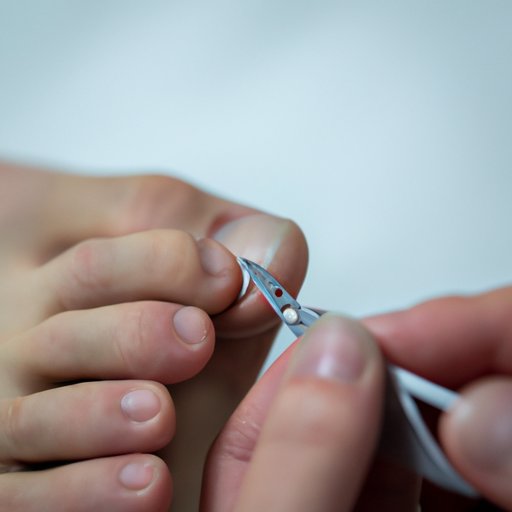
Introduction
Have you ever experienced a sharp pain in your toe? If you have, that may be a sign of an ingrown toenail. This common condition occurs when the edge of your toenail grows into the skin around the nail or when the skin around the nail grows over the toenail. The result is a painful, tender, and swollen area that can become infected if left untreated. In this article, we’ll discuss the symptoms of an ingrown toenail, how to diagnose it, what causes it, and how to prevent it from happening again.
Symptoms to Look Out For
The most common signs of an ingrown toenail include pain, redness, swelling, tenderness, and warmth around your toenail. You may also notice fluid draining from the area or a foul odor coming from your toe. Sometimes, the skin around the toenail may become infected, which can cause fever, red streaks on your foot, and pus. Ingrown toenails can closely resemble other foot conditions like infections, corns, calluses, or even Buerger’s disease, so if you are unsure of your symptoms, it’s advisable to consult a podiatrist.
Self-Diagnosis Steps
You can diagnose an ingrown toenail by gently examining the affected area. Start by soaking your foot in warm, soapy water for about 15 minutes to soften your skin and reduce swelling. Use a clean cotton swab to gently push the skin surrounding your toenail away from the nail. If your nail is ingrown, you may notice that the skin is tender and painful when you touch it. You can also try to gently lift the corner of the nail with a sterile tweezers to see if it is embedded in the skin. However, if you experience any discomfort or resistance, stop and seek professional medical advice.
Causes and Risk Factors
Ingrown toenails can be caused by several factors, but the most common cause is improper nail trimming. When you cut your toenails too short, trim them at a curve, or round the edges rather than cutting straight across, it can encourage the nail to grow into the skin. Wearing tight, ill-fitting shoes or socks can also add extra pressure and friction on your toes, causing the nail to become deformed. People with diabetes, blood circulation problems, or fungal infections in their toenails are also more susceptible to ingrown toenails.
Treatment Options
Fortunately, there are several treatment options for ingrown toenails that you can try at home or with medical assistance. For mild cases, you can soak your foot in warm water twice a day, use a clean cotton swab to apply an antibiotic ointment, and wear open-toed shoes or sandals to reduce pressure on your toe. You can also try to lift the edge of the ingrown nail with a sterile tweezers to get it to grow out straight. If your symptoms persist or worsen, a podiatrist may need to remove the ingrown nail or prescribe antibiotics to treat the infection.
Prevention Tips
The best way to prevent ingrown toenails is to take good care of your feet. Avoid cutting your toenails too short, and always trim them straight across and not too close to the skin. Wear comfortable shoes that fit well without being too tight or narrow. Keep your feet clean and dry, and if you have diabetes or any other medical conditions that affect your feet, inspect them regularly, and seek professional help at the first sign of a problem.
Conclusion
An ingrown toenail can be an irritating and painful condition, but it’s also incredibly common and treatable. By learning to recognize the symptoms, you can take proactive steps to address the issue before it becomes more severe. If you experience any of the signs discussed in this article, be sure to take care of your feet, and consult a podiatrist if you’re unsure about how to proceed.




